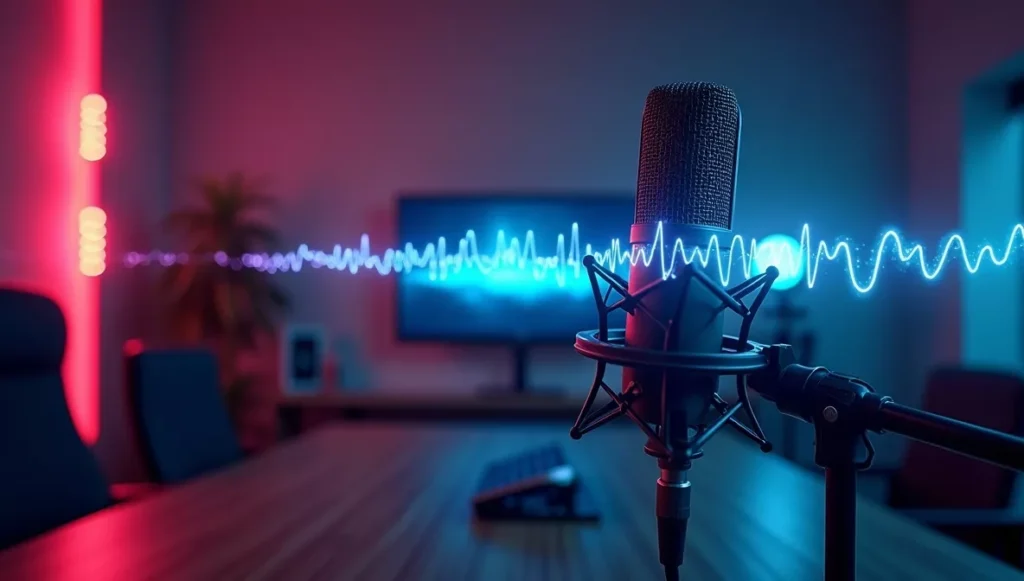Why Your Audio Sounds Like a Broken Radio (And How to Fix It)
Have you ever recorded a perfect podcast episode, only to discover that your dog was barking in the background? Or maybe your neighbor decided that 2 PM on a Tuesday was the perfect time to mow their lawn while you were recording your best YouTube video yet?
- Why Your Audio Sounds Like a Broken Radio (And How to Fix It)
- What Is AI Noise Removal and Why Should You Care?
- Why Is This Important for Content Creators?
- 💖 You Might Also Like
- The Most Common Audio Problems That AI Can Fix
- 1. Background Hum and Buzz
- 2. Traffic and Outdoor Noise
- 3. Echo and Room Reverb
- 4. Click, Pops, and Crackles
- 5. Wind Noise
- 6. Keyboard and Mouse Clicks
- The Best AI Tools for Noise Removal in 2025
- 1. Adobe Podcast AI (Adobe Enhance Speech)
- ✨ More Stories for You
- 2. Descript
- 3. Krisp
- 🌟 Don’t Miss These Posts
- 4. Audacity with Noise Reduction Plugin
- 5. Cleanvoice AI
- 6. iZotope RX
- 7. Auphonic
- 8. NVIDIA RTX Voice (Now NVIDIA Broadcast)
- How to Choose the Right AI Noise Removal Tool for You
- Ask Yourself These Questions:
- Tips for Getting the Best Results from AI Noise Removal
- 1. Start with the Best Recording Possible
- 2. Don’t Over-Process
- 3. Use Headphones to Check Your Audio
- 4. Keep Your Original Files
- 5. Process in Stages
- 6. Test Different Tools
- Common Mistakes to Avoid
- Mistake 1: Expecting Miracles from Terrible Audio
- Mistake 2: Using Only Noise Removal
- Mistake 3: Not Listening to the Results
- Mistake 4: Forgetting About Your Audience
- Mistake 5: Relying 100% on AI
- The Future of AI Noise Removal
- Real-Time AI Will Get Even Better
- Voice Cloning for Fixing Mistakes
- Automatic Background Music
- Emotion-Based Processing
- Real Success Stories from Content Creators
- Frequently Asked Questions
- Quick Start Guide: Your First AI Noise Cleanup
- Final Thoughts: Which Tool Should You Choose?
- The Bottom Line
- One More Thing…
If you’re nodding your head right now, you’re not alone. Millions of content creators face the same problem every single day. Background noise is like that uninvited guest who shows up to every party and ruins all the fun.
But here’s the good news: we live in an amazing time where artificial intelligence can clean up your audio faster than you can say “background noise.” And the best part? You don’t need to be a sound engineer or spend thousands of dollars on fancy equipment.
In this guide, we’re going to explore the best AI tools that can make your audio sound crystal clear, even if you recorded it in the middle of a busy coffee shop. Whether you’re a podcaster, YouTuber, or someone who just wants their videos to sound professional, this article is for you.
Let’s dive in!
What Is AI Noise Removal and Why Should You Care?
Imagine you have a magic eraser that can remove only the sounds you don’t want, while keeping your voice perfectly clear. That’s exactly what AI noise removal does.
AI (artificial intelligence) noise removal uses smart computer programs that can listen to your audio and identify what’s your voice and what’s unwanted noise. It’s like having a super-smart assistant who can pick out all the bad sounds and delete them, leaving only the good stuff.
Why Is This Important for Content Creators?
Think about the last time you watched a video or listened to a podcast with terrible audio quality. How long did you stick around? Probably not very long, right?
Studies show that people will forgive bad video quality, but they won’t forgive bad audio quality. If your audio sounds unprofessional, people assume your content is unprofessional too. It’s not fair, but it’s true.
Good audio quality makes you sound:
- More professional and trustworthy
- Easier to understand and listen to
- More enjoyable to watch or hear
- Like someone who takes their craft seriously
Bad audio quality makes people click away faster than you can say “subscribe and hit the bell icon.”
💖 You Might Also Like
The Most Common Audio Problems That AI Can Fix
Before we talk about the best tools, let’s understand what kinds of noisy neighbors AI can kick out of your audio.
1. Background Hum and Buzz
This is that annoying “hummmmm” sound that comes from electrical equipment, computers, fans, or air conditioners. It’s like a mosquito buzzing in your ear that never goes away.
2. Traffic and Outdoor Noise
Cars honking, airplanes flying overhead, people talking outside your window – all the sounds of the outside world trying to crash your recording party.
3. Echo and Room Reverb
Ever recorded in an empty room and sounded like you were inside a cave? That’s reverb. It makes your voice bounce around and sound weird and hollow.
4. Click, Pops, and Crackles
These are little annoying sounds that pop up randomly, like when you accidentally hit the microphone or when your mouth makes clicking sounds.
5. Wind Noise
If you record outdoors, wind can sound like a hurricane on your recording, even if it’s just a gentle breeze.
6. Keyboard and Mouse Clicks
For gamers and tutorial creators, the sound of typing and clicking can be super distracting for viewers.
The good news? Modern AI tools can handle all of these problems and more. Now let’s look at the best tools available.
The Best AI Tools for Noise Removal in 2025
1. Adobe Podcast AI (Adobe Enhance Speech)
Best For: Beginners and anyone who wants instant results
Price: Free (with some limitations)
Adobe Podcast AI is like magic in a button. Seriously. You upload your audio, click one button, and boom – your audio sounds like it was recorded in a professional studio.
How It Works:
Adobe’s AI was trained by listening to millions of hours of audio recordings. It learned what clean, professional audio sounds like, and what noise sounds like. When you upload your file, the AI automatically removes background noise, echo, and makes your voice sound clear and crisp.
The Cool Features:
- One-click enhancement – it literally couldn’t be easier
- Removes echo and reverb automatically
- Makes your voice sound fuller and more professional
- Works directly in your web browser – no software to download
- Free for files up to a certain size
The Not-So-Cool Parts:
✨ More Stories for You
- The free version has limitations on file size and number of files
- You can’t control exactly how much processing happens
- Requires uploading files to Adobe’s servers (needs internet)
Who Should Use It:
Perfect for podcasters and video creators who want quick results without fussing with complicated settings. If you’re just starting out and want your audio to sound professional without becoming a sound engineer, this is your tool.
2. Descript
Best For: Video creators and podcasters who want an all-in-one solution
Price: Starts free, paid plans from $12/month
Descript is like the Swiss Army knife of audio and video editing. It does way more than just noise removal, but its AI-powered “Studio Sound” feature is absolutely incredible.
How It Works:
Descript uses AI to analyze your recording and identify what’s speech and what’s noise. The coolest part? You can edit your audio by editing text, like editing a Word document. It transcribes everything you say, and when you delete words from the transcript, it deletes them from the audio. Mind. Blown.
The Cool Features:
- Studio Sound makes any recording sound professional with one click
- Edit audio by editing text – seriously, this is revolutionary
- Remove filler words (um, uh, like) automatically
- Create audiograms for social media
- Works with both audio and video
- Has a free version with generous limits
The Not-So-Cool Parts:
- Can be overwhelming if you just want simple noise removal
- Learning curve is steeper than simpler tools
- The free version limits transcription hours
Who Should Use It:
Video creators and podcasters who want a complete editing solution. If you’re creating content regularly and want to speed up your entire workflow, Descript is worth learning.
3. Krisp
Best For: Live calls, streaming, and real-time noise removal
Price: Free for limited minutes, paid plans from $8/month
Krisp is unique because it works in real-time while you’re recording or on calls. It’s like having a bouncer at the door of your audio who only lets your voice through.
How It Works:
🌟 Don’t Miss These Posts
Krisp sits between your microphone and whatever app you’re using (Zoom, Skype, OBS, etc.). Its AI listens to your audio in real-time and removes background noise before it even gets recorded. This means your Zoom calls sound crystal clear, even if you’re calling from a noisy coffee shop.
The Cool Features:
- Works in real-time with any app
- Removes background noise on both ends of calls
- Cancels echo automatically
- Has a free tier with 60 minutes per week
- Works on both Windows and Mac
- Can remove background noise from video calls
The Not-So-Cool Parts:
- Free version is limited to 60 minutes per week
- Requires installation on your computer
- Uses some computer processing power
Who Should Use It:
Perfect for people who do a lot of live streaming, video calls, or online meetings. If you’re a gaming streamer, online teacher, or remote worker, Krisp is a game-changer.
4. Audacity with Noise Reduction Plugin
Best For: Budget-conscious creators who don’t mind a learning curve
Price: Completely free
Audacity is the granddaddy of free audio editing software. While its AI isn’t as fancy as the newer tools, its noise reduction features are still powerful and it costs exactly zero dollars.
How It Works:
Audacity’s noise reduction works by creating a “noise profile.” You select a section of your audio that’s just noise (no speaking), and Audacity learns what that noise sounds like. Then it removes that noise pattern from your entire recording.
The Cool Features:
- Completely free and open-source
- No subscriptions or limits
- Lots of control over how much noise to remove
- Active community with tutorials
- Works offline – no internet needed
- Available on Windows, Mac, and Linux
The Not-So-Cool Parts:
- Not as automatic as AI-powered tools
- Steeper learning curve
- Interface looks old-fashioned
- Can sound unnatural if you’re not careful with settings
- Requires manual tweaking
Who Should Use It:
Great for creators on a tight budget who are willing to learn the basics of audio editing. If you’re starting out and can’t afford paid tools, Audacity is your friend.
5. Cleanvoice AI
Best For: Podcasters who want automated post-production
Price: Pay-as-you-go or subscription starting at $10/month
Cleanvoice is built specifically for podcasters. It’s like hiring an audio editor who works for pennies and never sleeps.
How It Works:
Upload your podcast recording, and Cleanvoice’s AI automatically removes filler words, mouth sounds, clicking, background noise, and even dead silence. It can also identify and remove stuttering and long pauses.
The Cool Features:
- Removes filler words automatically (um, uh, like, you know)
- Detects and removes mouth clicks and sounds
- Cuts out long silences
- Removes background noise
- Available in 30+ languages
- Timeline shows exactly what was removed
The Not-So-Cool Parts:
- Designed specifically for speech/podcasts
- Not ideal for music or complex audio
- Requires uploading files to their servers
- Can be aggressive with removing sounds
Who Should Use It:
Perfect for podcasters who want to save hours of editing time. If you’re publishing podcasts regularly and hate removing all those “ums” and “ahs” manually, Cleanvoice will change your life.
6. iZotope RX
Best For: Professional audio engineers and serious creators
Price: Starts at $399 (expensive but powerful)
iZotope RX is the professional-grade tool that sound engineers in Hollywood use. It’s like bringing a nuclear weapon to a water gun fight – incredibly powerful but also complex.
How It Works:
RX uses advanced AI and machine learning algorithms to identify and remove noise with surgical precision. You can literally see your audio as a picture and “paint away” the noise you don’t want.
The Cool Features:
- Most powerful noise removal available
- Visual editing lets you see and remove specific sounds
- Multiple specialized modules for different problems
- Dialogue isolation is magical
- Used in professional film and TV production
- Can fix almost any audio problem
The Not-So-Cool Parts:
- Very expensive
- Steep learning curve
- Overkill for most creators
- Requires a powerful computer
- Takes time to learn properly
Who Should Use It:
Professional audio engineers, serious video producers, and creators who need the absolute best quality and have the budget for it. If you’re just starting out, this is probably too much tool for you.
7. Auphonic
Best For: Automatic audio optimization and podcast distribution
Price: Free for 2 hours/month, paid plans from $11/month
Auphonic is like having a smart assistant who not only cleans your audio but also makes sure it sounds consistent and professional across all platforms.
How It Works:
Upload your audio, and Auphonic’s AI automatically adjusts levels, removes noise, balances speakers, and even adds chapter markers. It can also automatically publish your podcast to multiple platforms.
The Cool Features:
- Automatic leveling (loudness normalization)
- Noise and hum reduction
- Multi-track processing
- Automatic podcast distribution
- Creates chapters and metadata
- Very consistent results
The Not-So-Cool Parts:
- Free tier is limited to 2 hours per month
- Interface can be confusing at first
- Not as much manual control as some tools
- Processing can take a while for long files
Who Should Use It:
Podcasters who want a complete automated workflow from recording to publishing. If you want to spend less time on technical stuff and more time creating content, Auphonic is excellent.
8. NVIDIA RTX Voice (Now NVIDIA Broadcast)
Best For: Gamers and streamers with NVIDIA graphics cards
Price: Free (requires compatible NVIDIA GPU)
If you have a gaming PC with an NVIDIA graphics card, you already have access to incredible AI noise removal technology for free.
How It Works:
NVIDIA Broadcast uses the AI processing power of your graphics card to remove background noise in real-time. It’s similar to Krisp but works specifically with NVIDIA GPUs and is completely free.
The Cool Features:
- Completely free with compatible hardware
- Real-time processing
- Very low latency
- Includes virtual background features
- Works with any app
- Minimal performance impact
The Not-So-Cool Parts:
- Only works with NVIDIA RTX graphics cards
- Windows only
- Requires a relatively recent GPU
- Limited to real-time use (not for post-production)
Who Should Use It:
Gamers, streamers, and content creators who already have an NVIDIA RTX graphics card. If you have the hardware, there’s no reason not to use this.
How to Choose the Right AI Noise Removal Tool for You
With so many options, how do you pick the right one? Here’s a simple guide.
Ask Yourself These Questions:
1. What’s Your Budget?
If you’re just starting out and have no budget:
- Use Adobe Podcast AI (free tier)
- Try NVIDIA Broadcast (if you have the hardware)
- Use Audacity (completely free)
If you have a modest budget ($10-20/month):
- Descript is amazing value
- Cleanvoice for podcasters
- Krisp for live work
If you’re a professional with budget:
- iZotope RX is the gold standard
2. When Do You Need Noise Removal?
For real-time (during recording/calls):
- Krisp
- NVIDIA Broadcast
For post-production (after recording):
- Adobe Podcast AI
- Descript
- Cleanvoice
- Auphonic
- iZotope RX
3. What Type of Content Do You Create?
For podcasts:
- Cleanvoice
- Descript
- Auphonic
For YouTube videos:
- Descript
- Adobe Podcast AI
For gaming/streaming:
- NVIDIA Broadcast
- Krisp
For professional audio:
- iZotope RX
4. How Technical Are You?
Beginner-friendly (just want it to work):
- Adobe Podcast AI
- Cleanvoice
Intermediate (willing to learn basics):
- Descript
- Krisp
- Auphonic
Advanced (want complete control):
- iZotope RX
- Audacity
Tips for Getting the Best Results from AI Noise Removal
AI is powerful, but it’s not perfect. Here are some tips to get the best results:
1. Start with the Best Recording Possible
Remember: AI can’t create something from nothing. It’s like fixing a photo – you can make a good photo great, but you can’t make a terrible photo amazing.
Tips for better recordings:
- Record in the quietest room you can find
- Use a decent microphone (doesn’t have to be expensive)
- Get close to the microphone (6-8 inches away)
- Turn off fans, air conditioners, and other noise sources when recording
2. Don’t Over-Process
More AI processing isn’t always better. If you apply too much noise removal, your voice can start to sound robotic or underwater.
Start with gentle settings and only increase if needed.
3. Use Headphones to Check Your Audio
Your computer speakers might make your audio sound better than it really is. Always check your processed audio with headphones to hear the true quality.
4. Keep Your Original Files
Always save a copy of your original, unprocessed audio. If the AI processing doesn’t work out, you can try again with different settings.
5. Process in Stages
For really noisy audio, try processing in stages:
- First, remove background noise
- Then, adjust levels and volume
- Finally, add any finishing touches
6. Test Different Tools
Many of these tools have free trials. Don’t be afraid to test a few and see which one sounds best for your voice and recording situation.
Common Mistakes to Avoid
Let’s talk about what NOT to do:
Mistake 1: Expecting Miracles from Terrible Audio
If you recorded your podcast in the middle of a rock concert, no AI can make it sound like a studio recording. AI is powerful but not magical.
Mistake 2: Using Only Noise Removal
Noise removal is just one part of good audio. You also need to think about:
- Volume levels (loudness)
- Compression (making quiet and loud parts more consistent)
- EQ (making your voice sound better)
Mistake 3: Not Listening to the Results
Always listen to your processed audio all the way through before publishing. Sometimes AI can create weird artifacts or remove things you wanted to keep.
Mistake 4: Forgetting About Your Audience
Test your audio on different devices – phones, tablets, computers, cheap earbuds. Your audience isn’t listening on studio monitors.
Mistake 5: Relying 100% on AI
AI is a tool, not a replacement for good recording practices. The better your original recording, the better your final result will be.
The Future of AI Noise Removal
The technology is getting better every single day. Here’s what’s coming:
Real-Time AI Will Get Even Better
Soon, AI noise removal will be so good and so fast that you won’t be able to tell it’s even working. It’ll be like having a professional sound engineer in your computer.
Voice Cloning for Fixing Mistakes
Some AI tools are starting to use voice cloning to fix mistakes. Made a mistake while recording? The AI can generate a correction in your own voice.
Automatic Background Music
AI will be able to add appropriate background music that automatically ducks (gets quieter) when you’re speaking and comes back up during pauses.
Emotion-Based Processing
Future AI might adjust your audio processing based on the emotion of what you’re saying – making exciting moments more punchy and intimate moments more warm.
Real Success Stories from Content Creators
Let’s hear from people who’ve used these tools:
Sarah, Podcast Host: “I started my podcast recording in my bedroom with my noisy computer fan always running. Adobe Podcast AI saved me. My listeners can’t even tell I’m not in a studio. It’s incredible and free!”
Mike, YouTube Gamer: “NVIDIA Broadcast changed my streaming game. My mechanical keyboard used to be so loud in my streams. Now my viewers only hear my voice. It’s like magic.”
Jennifer, Video Course Creator: “I recorded an entire online course before realizing my air conditioner was on the whole time. Descript’s Studio Sound saved 20 hours of recording. I almost cried with relief.”
Frequently Asked Questions
Q: Can AI noise removal work on videos too? Yes! Most of these tools work on the audio extracted from video files. Tools like Descript work directly with video files.
Q: Will AI noise removal make my voice sound weird? If used correctly, no. The best AI tools are designed to make your voice sound natural. Only aggressive processing makes voices sound robotic.
Q: Can I use these tools for music recordings? Some can, but most are optimized for speech. For music, you’d want specialized tools like iZotope RX or specific music production software.
Q: Do I need a powerful computer? For post-production tools (Adobe Podcast, Cleanvoice), no – processing happens in the cloud. For real-time tools (Krisp, NVIDIA Broadcast), you need a decent computer.
Q: Is it cheating to use AI noise removal? Absolutely not! Professional studios use noise removal tools all the time. It’s just part of making professional-quality content.
Q: Can AI remove people talking in the background? Sometimes. It depends on how loud they are relative to your voice. AI is best at removing consistent background noise, not intermittent speech.
Q: What if I’m recording multiple people? Most AI tools can handle multiple speakers, but make sure each person has their own microphone for best results.
Quick Start Guide: Your First AI Noise Cleanup
Let’s get you started right now with Adobe Podcast AI (free):
Step 1: Go to podcast.adobe.com/enhance
Step 2: Sign up for a free Adobe account (takes 2 minutes)
Step 3: Click “Upload audio file” and select your recording
Step 4: Wait for the processing (usually 1-2 minutes)
Step 5: Click “Download” and listen to your amazingly clean audio
Step 6: Do a happy dance because your audio sounds professional!
Seriously, it’s that easy. You can have professional-sounding audio in less than 5 minutes.
Final Thoughts: Which Tool Should You Choose?
Here’s my honest recommendation:
If you’re just starting out: Begin with Adobe Podcast AI. It’s free, ridiculously easy, and produces great results. You literally can’t go wrong.
If you’re creating content regularly: Invest in Descript. Yes, it costs money, but it’ll save you hours every week and make your entire workflow faster.
If you do live streaming or calls: Get Krisp or NVIDIA Broadcast (if you have the hardware). Real-time noise removal is a game-changer for live content.
If you’re a professional: Eventually, you’ll want iZotope RX. It’s expensive, but it’s the best.
If you’re a podcaster on a budget: Try Cleanvoice. It’s specifically built for podcasts and automates so much of the tedious work.
The Bottom Line
Here’s the truth: your content deserves to sound good. Your ideas are worth hearing clearly. Your voice matters.
Bad audio is no longer an acceptable excuse. With these AI tools, anyone can have professional-quality audio without spending thousands of dollars or years learning audio engineering.
The hardest part isn’t the technology – it’s getting started. So pick one tool from this list (I recommend starting with Adobe Podcast AI), and try it on your next recording. You’ll be amazed at the difference.
Remember: every professional creator started as a beginner. The difference between them and everyone else is that they started. They tried things. They learned. They improved.
You can do this too.
Now stop reading and go make some amazing content with crystal-clear audio. Your audience is waiting to hear what you have to say.
One More Thing…
If you found this guide helpful, the best way to improve your audio is to practice. Record something today. Clean it up with one of these tools. Listen to the difference. Then do it again tomorrow.
That’s how you get better. Not by reading guides (though they help), but by actually doing the work.
Good luck, and may your audio always be crystal clear!
Your Turn: Which AI noise removal tool are you going to try first? Have you used any of these tools before? Whatever your experience level, remember that better audio quality is just a few clicks away.
The future of content creation is here, and it sounds amazing.
Happy creating!















